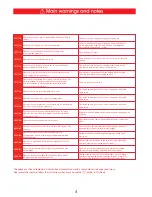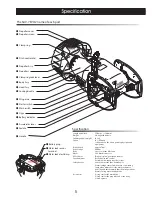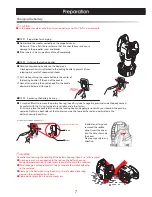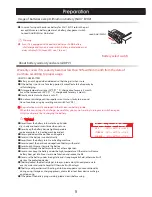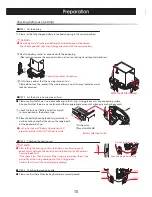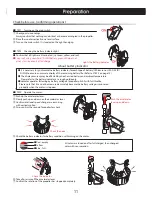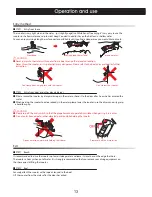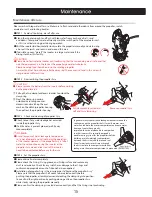
●
Action when trouble is found.
Please turn the main switch on.
●
Action when trouble is found.
Please connect the battery connector correctly.
●
Action when trouble is found.
Please recharge your existing battery and try again.
●
Action when trouble is found.
Please dry around two sensor screws that are located on the top of
the bulkhead.
●
Action when trouble is found.
Normal operation can be expected after repair..
Please request your local dealer to repair the scooter if you do not
understand the repair method.
Symptoms : The propeller doesn't rotate even though the accelerator lever is activated.
Water leak alert lamp
Water leak sensor terminal
Check1 : The scooter won't activate.
Check2 : The battery may not be connected correctly.
Check5 : The water sensor may have been activated.
Please advice the dealer that the scooter is not operating even after all the above points were addressed and
checked.
Check4 : Is the battery charged?
Check3 : Can you push the red accelerator unit switch button on the side of the scooter main body down firmly?
●
Please confirm the battery indicator lights are on.
Please go to the following step if the scooter
still does not operate.
Please go to the following step if the battery is
connected correctly.
Please go to the following step if the accelerator
seems to be working correctly.
Please go to the following step if this sequence of
troubleshooting doesn't correspond.
If the symptom still persists after another fully
charged battery has been tried then please
go to the next step.
If the warning lamp has not turned off, or the warning lamp lights up
frequently, the scooter may be leaking.
Please request a full overhaul with your dealer.
●
Please open the head assy and confirm that the battery lead is not connected.
●
Visually confirm the operation of the switch.
●
Please open the head Assy cover, and confirm the warning lamp is on.
22
DANGER
●
Never scuba dive alone. Always dive under the buddy system. Diving alone could lead to serious injury and
death.
●
Due to the speed of the scooter depth & pressure change may happen faster than usual.
The diver must be aware at all times with regards the status of the diver's depth and direction and carefully
monitor the diver's ascent rate as rapid surfacing and collisions could cause serious injury or death.
Please practice driving at low speed until you become accustomed to the handling of the scooter.
●
There are screen on the propeller cover for preventing from entangling wire and seaweeds.
However, do not dive with the scooter at the seaweed area.
●
Equalization ears.
Ears are equalized in the same way as for regular diving. However, the speed will cause water pressure
changes faster. Therefore, ears must be equalized faster and more frequently than usual.
As the diver's face is often turned upward when in a riding position, it is best to draw the chin back when
equalizing the ears in order make the auditory canal open up more easily.
●
Buoyancy adjustment.
Because the diver's hands are freed up during hands-free riding, the diver is able to operate the inflator and
exhaust valve as the diver normally would. Because the body is horizontal when riding the scooter, its position
can be kept stable by discharging air using the exhaust valves located at the shoulders or hips.
●
Using fins as a stabilizer.
During hands-free riding, fins are used as stabilizers.
The diver should try to keep the fins positioned near the center of the propeller cover during regular or high-
speed runs, keeping fins even with the propeller shaft of the scooter. The water current created by the
propeller will hit the fins. This will help counter the force that pushes the scooter to rotate in a counterclockwise
direction (rotation torque). When running at a slow speed, the upper body will lift slightly, causing the knees
to lightly bend. In this case, the diver must try to keep the fins horizontal to the propulsion direction, so that,
here too, they can act as a stabilizer.
The TUSA underwater scooters are a multipurpose underwater scooter equipped with an innovative
"accelerator-based gear-less drive mechanism".
●
Shifting gears while running.
On former underwater scooters, the gears could only be shifted by manually changing the pitch of the
propeller while the scooter was in a stationary position.
Having to stop each time to change the speed was difficult and inconvenient.
●
To overcome this problem, the TUSA underwater scooter is now equipped with a mechanism that changes the
revolution speed of the motor. Now the gears can be shifted while running, eliminating the need to stop each
time.
The mechanism that changes the motor's revolution speed has made "gear-less" speed change possible.
Speed is no longer changed in phases by manual adjustment of the propellers pitch.
●
Propeller pitch conversion mechanism.
The TUSA underwater scooter is also equipped with a propeller pitch conversion mechanism.
Please refer to the pitch selection on page 12.
NOTE
In this book, it utilizes only the SAV-7 EVO2 diagram as an example.
Basic operation for another TUSA underwater scooters are same as the SAV-7 EVO2.
■
Speed control
For the safety diving.
Characteristics of the TUSA underwater scooter
23
18

